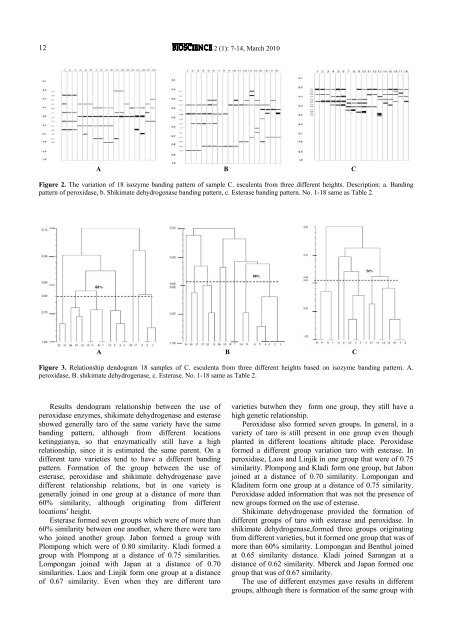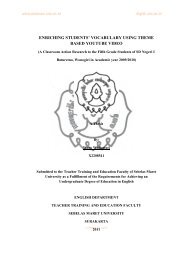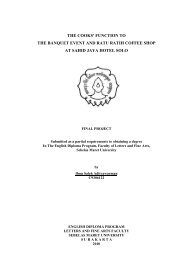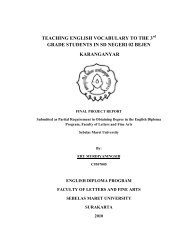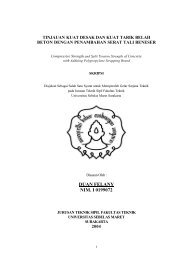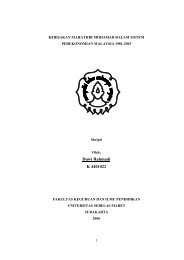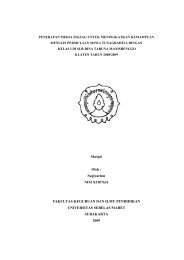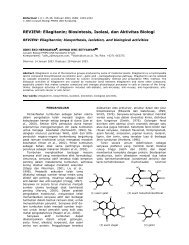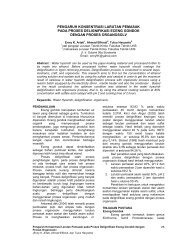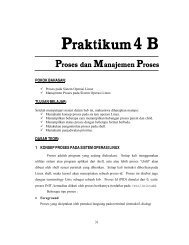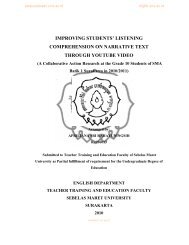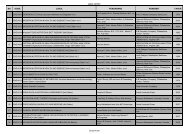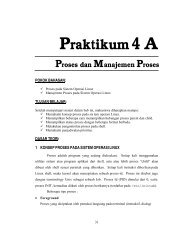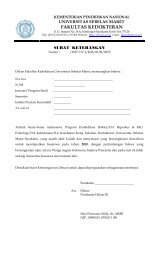ISSN 2087-3940 (PRINT) | ISSN 2087-3956 ... - Biodiversitas
ISSN 2087-3940 (PRINT) | ISSN 2087-3956 ... - Biodiversitas
ISSN 2087-3940 (PRINT) | ISSN 2087-3956 ... - Biodiversitas
Create successful ePaper yourself
Turn your PDF publications into a flip-book with our unique Google optimized e-Paper software.
12<br />
2 (1): 7-14, March 2010<br />
A B C<br />
Figure 2. The variation of 18 isozyme banding pattern of sample C. esculenta from three different heights. Description: a. Banding<br />
pattern of peroxidase, b. Shikimate dehydrogenase banding pattern, c. Esterase banding pattern. No. 1-18 same as Table 2.<br />
A B C<br />
Figure 3. Relationship dendogram 18 samples of C. esculenta from three different heights based on isozyme banding pattern. A.<br />
peroxidase, B. shikimate dehydrogenase, c. Esterase. No. 1-18 same as Table 2.<br />
Results dendogram relationship between the use of<br />
peroxidase enzymes, shikimate dehydrogenase and esterase<br />
showed generally taro of the same variety have the same<br />
banding pattern, although from different locations<br />
ketinggianya, so that enzymatically still have a high<br />
relationship, since it is estimated the same parent. On a<br />
different taro varieties tend to have a different banding<br />
pattern. Formation of the group between the use of<br />
esterase, peroxidase and shikimate dehydrogenase gave<br />
different relationship relations, but in one variety is<br />
generally joined in one group at a distance of more than<br />
60% similarity, although originating from different<br />
locations’ height.<br />
Esterase formed seven groups which were of more than<br />
60% similarity between one another, where there were taro<br />
who joined another group. Jabon formed a group with<br />
Plompong which were of 0.80 similarity. Kladi formed a<br />
group with Plompong at a distance of 0.75 similarities.<br />
Lompongan joined with Japan at a distance of 0.70<br />
similarities. Laos and Linjik form one group at a distance<br />
of 0.67 similarity. Even when they are different taro<br />
varieties butwhen they form one group, they still have a<br />
high genetic relationship.<br />
Peroxidase also formed seven groups. In general, in a<br />
variety of taro is still present in one group even though<br />
planted in different locations altitude place. Peroxidase<br />
formed a different group variation taro with esterase. In<br />
peroxidase, Laos and Linjik in one group that were of 0.75<br />
similarity. Plompong and Kladi form one group, but Jabon<br />
joined at a distance of 0.70 similarity. Lompongan and<br />
Kladitem form one group at a distance of 0.75 similarity.<br />
Peroxidase added information that was not the presence of<br />
new groups formed on the use of esterase.<br />
Shikimate dehydrogenase provided the formation of<br />
different groups of taro with esterase and peroxidase. In<br />
shikimate dehydrogenase,formed three groups originating<br />
from different varieties, but it formed one group that was of<br />
more than 60% similarity. Lompongan and Benthul joined<br />
at 0.65 similarity distance. Kladi joined Sarangan at a<br />
distance of 0.62 similarity. Mberek and Japan formed one<br />
group that was of 0.67 similarity.<br />
The use of different enzymes gave results in different<br />
groups, although there is formation of the same group with


